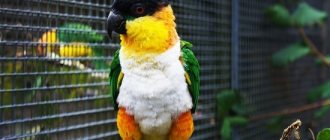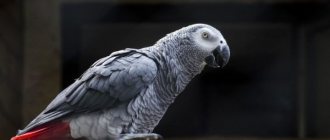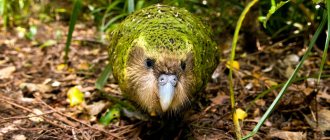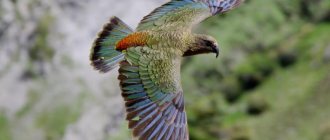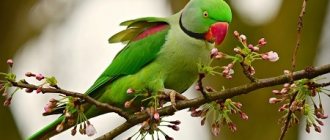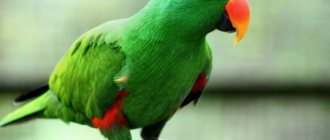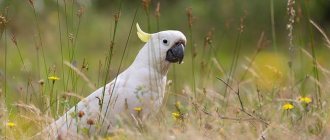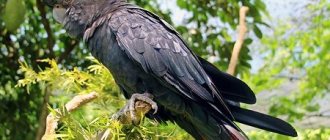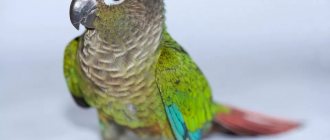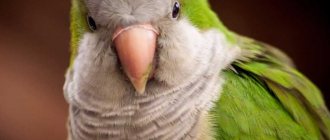Not everyone knows the name of the large New Zealand nocturnal parrot, which has a specific appearance and a shrill voice reminiscent of grunting or grunting.
This kakapo is an amazing bird because it cannot fly, being the owner of soft, light feathers that are not suitable for flight.
The only thing she can do with the help of her wings is to descend from the branches to the ground, parrying with them. This article will introduce you to the external features of a parrot with the face of a night owl, reveal the distinctive features of its character, tell you about the main habitat of the exotic bird, as well as how it feeds and reproduces.
Appearance
Kakapo is scientifically a large parrot, whose body length reaches 60–70 cm. Moreover, its weight varies from 2 to 5 kg. Males are more impressive in size than females. The feathers are predominantly rich green in color with dark yellow and black speckles. This feather shade protects the bird from predators and poachers, providing excellent camouflage in tree branches, where it is very difficult to see. The feathers on the head grow in the same way as on an owl.
Kakapo eyes are close-set, with blue irises. The beak of this breed is quite large, curved, and pointed. The pharynx is small compared to other species.
Initially, the skeleton was no different from the bone skeleton of other birds, but over time, due to the fact that the kakapo stopped flying, its skeleton underwent some changes. His wings acquired rounded outlines and became much shorter than before. Collarbones formed on the back. The bird has short, massive scaly legs, but long feet with four toes. The tail is short and thick.
The kakapo is called the owl parrot because of its ability to hide from light during the day and go out hunting at night.
The bird is well oriented in space even in pitch darkness. Vibrissae-like feathers located near the beak help her in this.
Description
The owl parrot got its name because it resembles an owl in appearance. The feathered representative has the same plumage with a fan structure and has a similar facial part of the head. If you see it for the first time, you can easily confuse it with an owl. Sometimes it is called the owl-faced parrot.
But the kakapo parrot is endowed with characteristic external signs that are worth paying attention to:
- Birds have light and soft feathers. Parrots of other breeds have strong and hard plumage, this is due to frequent flights;
- they have a yellow-green coloration that slowly becomes lighter in the ventral part;
- the bird is endowed with camouflage colors, so it may not be noticed among trees, mosses, and vegetation;
- on the head the feathers look like a disk. It also functions as a locator;
- Kakapo are heavy birds. Males can weigh 4 kg, and females can weigh 2.8 kg;
- body length - 60 cm;
- they have short and strong legs;
- small wings;
- they have a large and sharp beak. It is painted gray, but it becomes lighter towards the end;
- There are thin vibrissae around the beak, which allow birds to move in the dark.
It is worth noting one more characteristic feature - parrots smell strongly. The smell from them is cloying, but it is pleasant. It resembles a floral honey aroma. According to scientific research, it has been found that this is how birds get to know each other.
The parrot that doesn't fly
This is the only flightless parrot in the world. Yes, it does not fly; this function is not necessary for it. He has wings, like any bird, but they are short. With the help of them, he cannot fly long distances; at most he can fly up a tree and descend from it to the ground.
When danger arises, they do not require wings; they can quickly move on strong legs over long distances. They have wide, prehensile feet that allow them to climb high into trees. They also allow you to maintain stability when landing from a great height.
Habits
Kakapo parrots are endowed with a kind, not at all warlike character. They show friendliness and affection. In character, they are very reminiscent of pets, because they constantly require love, affection and attention.
It is a nocturnal parrot because it is more active at night. Feathered birds are sociable, they easily find a common language with people, and they can learn techniques and tricks.
Lifestyle
The parrot, which is similar in appearance and habits to an owl, unlike other breeds, digs holes, choosing places near the roots of trees and bushes. The bird hides in these burrows during daylight hours. Often one bird can have several holes at the same time, since it does not always have time to return to its home before dawn, it is necessary to make a new one where necessary.
The parrot is meticulous in arranging its home, dragging grass, branches, and foliage there. The hole has several exits so that in case of danger you can go out into one of them, so the hole resembles a tunnel.
Living in pairs, birds make two rooms in their burrow. The newly born chicks live in one of them.
Each individual in the forest has its own habitat. For males, its area is 20–30 hectares, for females – 40–50 hectares. During difficult periods, birds accumulate fat, at which time their gait resembles that of a duck.
Sensing danger, kakapo instantly freeze in place, thus camouflaging themselves by merging with the vegetation of the forest.
Kakapo rarely live anywhere other than the New Zealand island. This is due to the presence of plants on it, whose flowering stimulates the beginning of the mating season of birds of this breed.
Not a cage - an aviary
Locked up in a cramped room, the kakapo becomes sad and sick, but in the spacious enclosure of the state reserve it feels great. Will a private owner be able to arrange everything so that the relief and landscape almost completely replicate the natural ones? Even if he has the power to do this, it is strictly prohibited.
It must be remembered that the parrot’s natural habitat is remote areas with trees and bushes, where with its powerful paws it digs huge branched holes with a separate bedroom with two entrances. It is clear that a cage in an apartment is not for such a pet.
Aviary for a kakapo parrot
Nutrition
What is a New Zealand kakapo and what does the unusual bird eat are pressing questions for those who are not yet familiar with the parrot of this breed. In the wild, the diet of the owl parrot is quite varied, consisting of plants, berries, fruits, and small reptiles. This way, all the necessary substances that contribute to its health and activity enter the bird’s body.
Here's what kakapo eats:
- miniature reptiles;
- sphagnum;
- berries, fruits, nuts, seeds;
- roots, mushrooms, plant pollen;
- plant juice;
- insects.
The favorite delicacy of birds is the fruit of Dacridium cypress, for which they have to climb a tree 20 m or more high. Having obtained the fruit, the parrot maneuvers to the ground with the help of its wings. Kakapo does not eat animal food.
Interesting Facts
Since the owl parrot is on the verge of extinction, the New Zealand authorities are pursuing a policy to preserve this species and are trying to breed kakapo in nature reserves and zoos. However, these birds are not very willing to breed in captivity.
Kakapo are not afraid of people. On the contrary, some individuals behave like domestic cats: they are affectionate towards people and love to be stroked. Having become attached to a person, they are able to beg for attention and treats.
The mating period occurs during the fruiting period of the rimu tree, the fruits of which form the basis of the owl parrot's diet. The fact is that the fruits of this unique tree are rich in vitamin D. This vitamin is responsible for the reproductive ability of these unique birds.
The rimu tree is the only source of the vitamin in the amount they need. In search of their favorite delicacy, they are able to climb up rocks and trees to a fairly impressive height - up to 20 meters.
Kakapo can display during the mating season like grouse
back down from the tree , spreading its wings at an angle of 45 degrees. In the process of evolution, its wings became unsuitable for long flights, but they allow it to descend from tall trees and cover a distance of 25 to 50 meters.
In addition, to support the parrot population in the years when the rimu does not bear fruit, scientists feed the kakapo with a special food with the necessary vitamin D content to help the birds raise healthy offspring.
This is the only species of parrots that, like black grouse, displays during the mating season. To produce specific sounds they use a “throat pouch”. And the sounds they make are also called “talking” by scientists. When calling for a partner, the male is able to inflate his feathers, and looks like a fluffy green ball.
Currently, the kakapo is on the verge of extinction. This was primarily facilitated by local tribes who caught them for food. And with the development of agriculture on the islands of New Zealand, local residents began to massively cut down forests to make room for planting yams and sweet potatoes - kumara.
Thus, unwittingly depriving the kakapo of its natural habitat. No less damage to the population was caused by Europeans, who brought cats and other animals that ate parrot meat to these places.
Despite the fact that these birds are not suitable for life in captivity, for many centuries people have tried to keep them in their homes. For example, these birds were first brought to Europe, in particular to Ancient Greece from India, by one of the generals named Onesicritus.
In those days in India it was believed that a parrot should live in the house of every noble person. These birds instantly gained popularity and love among the Greeks, and then the rich residents of Ancient Rome became interested in them.
The price of kakapo reached exorbitant amounts, since every self-respecting rich person considered it his duty to own such a bird. When the Roman Empire fell, kakapo also disappeared from European homes.
The second time kakapo came to Europe was during numerous crusades. However, the birds often died along the way, so only representatives of the highest nobility could afford to keep them at home.
Reproduction
How do flightless individuals copulate if they try to stay as far as possible from other relatives and animals? Puberty in males occurs at the age of four, while in females the desire to have offspring begins at 5–6 years. It is not easy to find a partner for a bird leading a reclusive lifestyle. The search is complicated by the fact that one individual occupies a large territory. A peculiar ritual helps the male find a partner: the kakapo climbs as high as possible on the hill, inflates its throat and begins to make special sounds that attract the attention of females. He makes a hole in the soil, lowers his head there and begins to scream so that his scream can be heard within a radius of several kilometers. He does this several times in a row.
The female who hears the calling sound goes to the place where it comes from. After the meeting, the parrots copulate. The female bears the offspring, makes a nest, and evaporates the chicks. The partner does not stay in one place, he begins to look for a new female due to the polygamy inherent in kakapo nature.
Thus, during one mating season, this breed is capable of fertilizing several females. But he does not participate in raising and feeding the chicks.
New Zealand parrots lay 2–3 eggs and incubate the chicks for a month, periodically leaving the nest to feed. The hatched chicks remain with their mother for up to a year or longer, as they slowly mature, remaining defenseless for a long time. They don’t have much chance of survival, since the kids are constantly being hunted by snakes, rats and other forest inhabitants.
The kakapo owl parrot is considered a long-liver, as in the wild it can live up to 100 years.
Can I keep it at home?
The kakapo night parrot attracts people with its unusual appearance and habits. Naturalists note his courage and gullibility. Even in the forest, having noticed a person, a curious bird calmly approaches him, climbs onto his back, and allows him to pull himself together. In captivity it takes root well and easily tolerates captivity. The free sale of owl parrots, or kakapos, is prohibited. They cannot be taken out of their native territory, nor should they be kept locked in apartments.
The character of the kakapo is reminiscent of a dog: it is just as good-natured and humble, and easily becomes attached to a person. People don't know as much about them as they do about other parrots, but these birds are worthy of attention and care. Thanks to the efforts of volunteers and ornithologists, the number of owl parrots is gradually increasing.
Threats and security
There are not many individuals left on earth of the amazing breed of kakapo parrots, and today they are in danger of extinction. Interesting unusual birds live on two New Zealand islands. In total, their number is only 51 individuals.
Scientists are interested in preserving the unique owl breed. The New Zealand Ministry of the Environment is developing measures to protect parrots from the predators that exterminate them. In addition, people provide birds with additional food, making their habitat more favorable so that they reproduce more actively.
Now it becomes clear what kind of parrot is considered a night parrot and why such individuals cannot fly, as well as why it is called an owl.
Previous
All typesRinged species of parrots and their features
Next
All types of Lori parrots - a multi-colored breed with a brushed tongue
Habitat
They are found in the southwest of New Zealand in humid highlands, as well as in areas where there is a lot of turf or shrubs, and occasionally in coastal areas.
They also settle where many favorite plants grow:
- dacridium cypress (rimu);
- pseudotsugi yew leaf;
- Polycarpus dacridiiformes;
- totara;
- nothofagus;
- tawa;
- Metrosideros umbelliferum;
- makomako;
- rubus (raspberry);
- coriaria;
- hebe;
- coprosmas.
Thickets of these plants are called “Kakapo gardens”.
At the moment, populations can be found on the islands of Anchor, Stewart, and Codfish.
Etymology
The scientific name Strigops habroptila was formed by combining the ancient Greek words strix ("owl"), ops ("face"), habros ("soft") and ptilon ("feather"). Initially, scientists believed that this bird could be a close relative of such species as the night parrot and the Australian ground parrot. However, in the course of research it turned out that kakapo (as this bird was called by the indigenous inhabitants of New Zealand - the Maori tribes) is unique and has no connection with the named individuals. Due to the large number of characteristic features, the bird was assigned to a separate rank called Strigopini. Ornithologists have discovered facts confirming that the New Zealand kaka and kea are in the same family with a parrot that looks like an owl. Apparently their common ancestor did not survive to our times, so it was possible to discover the relationship only with the help of phylogenetic studies.
Diet of birds
According to research conducted in 1984, these large endemic parrots from New Zealand feed on 25 species of diverse plants. They are partial to ripe fruits, berries and the bark of young trees. The fruits of a plant called rimu by Maori deserve special love from birds. If there are enough of them, birds are ready to eat them all season.
The owl parrot follows a characteristic diet. Each season it feeds on certain plants. This diet allows you to get the vitamins necessary for development and not destroy endemic plants. Birds do not consume animal or human food.
How long do kakapos live?
Under natural conditions, these birds live for about 90 years. According to research by zoologists, the owl species of parrots is a long-lived species, and is also one of the oldest species of birds to appear on earth. This is evidenced not only by the close relationship with kea parrots, but also by skeletal transformations that occurred millions of years ago. Followers of Charles Darwin put forward a hypothesis stating that the re-adaptation of this species of birds is direct evidence of their antiquity. It is not yet possible to find out more precisely how many years kakapo live on earth.
Communication with brothers
The owl parrot prefers loneliness in its own territory. Meetings with relatives occur no more than once every two years. Among the characteristic features of these birds is the smell that the male produces. The very strong aroma of honey and fruit attracts girlfriends to it.
Read also
Waka food for parrots reviews
Kakapo erects a real architectural structure: on a selected elevation he digs a bowl-shaped hole, sits in it and loudly calls out to his chosen one. The sound intensifies as the pothole deepens. He has several such “bowls”, and he walks around them in turn every night for eight hours. He's even losing weight. Loses up to half of its weight. The mating season lasts for three whole months. The girls come running one after another to hear the beautiful song and sweet smell of the male.
https://www.youtube.com/watch?v=mfbTz1DrOZI
